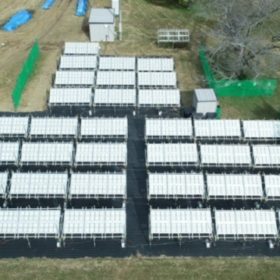Chinese PV Industry Brief: Polysilicon, solar module prices continue to slide
Polysilicon prices fell again this week amid weak market activity and elevated inventories, according to industry sources. Downstream wafer, cell, and module prices also continued to slide, with modules now trading as low as CNY 0.68 ($0.09)/W.
Narada Power debuts 783 Ah cell, 8.3 MWh solid state battery
The new 20-foot Center L Max system is configurable for storage durations ranging from two to eight hours and is compatible with 2000 V platforms. It utilizes the manufacturer’s proprietary 783 Ah cells, which feature an oxide solid electrolyte.
HyperStrong unveils utility-scale battery storage system housed in 10-foot container
The MagicBlock utility-scale storage platform supports two-hour to eight-hour discharge durations, targeting flexibility markets and long-duration energy storage needs. The 10-foot container supports a maximum capacity of 3.2 MWh and is available in both AC- and DC-coupled versions.
Solex Energy to open 2 GW TOPCon cell plant in 2027
India’s Solex Energy has started working on its new 2 GW n-type tunnel oxide passivated contact (TOPCon) solar cell factory, with operations set to begin in early 2027.
Japanese scientists build bendable perovskite-silicon tandem solar cell with 26.5% efficiency
The tandem device is based on a bottom thin-film heterojunction cell that can bend and a top perovskite cell that can be manufactured with a low-temperature process to prevent damage. It achieved the highest efficiency ever recorded to date for a flexible perovskite-silicon tandem solar cell.
Sunwoda launches the world’s first 10-metre, 2 MWh mobile energy storage system
Sunwoda’s MESS 2000 mobile energy storage vehicle redefines the role of mobile power—evolving from a tool for emergencies to a key player in everyday energy supply.
Japan launches subsidy program to cut costs of renewable heat systems
The Japanese government says it has opened applications for a subsidy initiative aimed at cutting costs for renewable heat and industrial waste heat systems. The program supports equipment upgrades that lower emissions and improve energy efficiency.
Aisin Corporation starts perovskite solar PV outdoor trial
The Japanese automotive components and systems manufacturer began testing its proprietary organic perovskite solar modules in what will be a 30 kW outdoor field trial at one of its facilities in Anjo.
Research shows how Japan’s PV market suffered from high feed-in tariffs
A team of researchers based in Japan and Sweden have found a correlation between higher feed-in tariffs and increased capital expenditures of solar projects in Japan. They suggest this may have led to a lack of incentive for developers to innovate or reduce costs, in turn inflating expenditure and hindering long-term market competitiveness.
Kosol Energie launches TOPCon solar module with 24% efficiency
The Indian manufacturer said its new n-type TOPCon bifacial solar module has a a power output of 585 W to 620 W and the same compact dimensions as a traditional 550 W panel.










